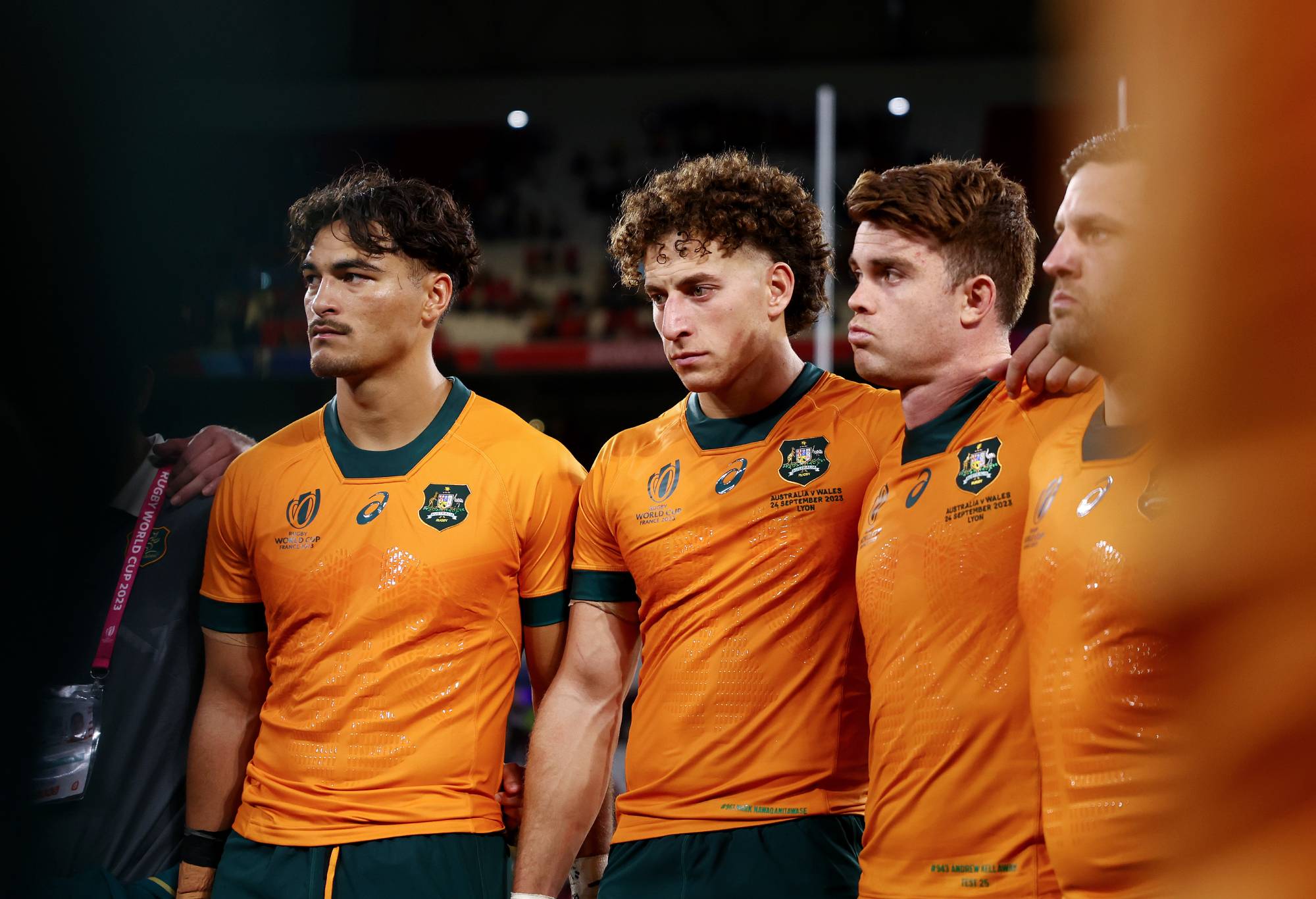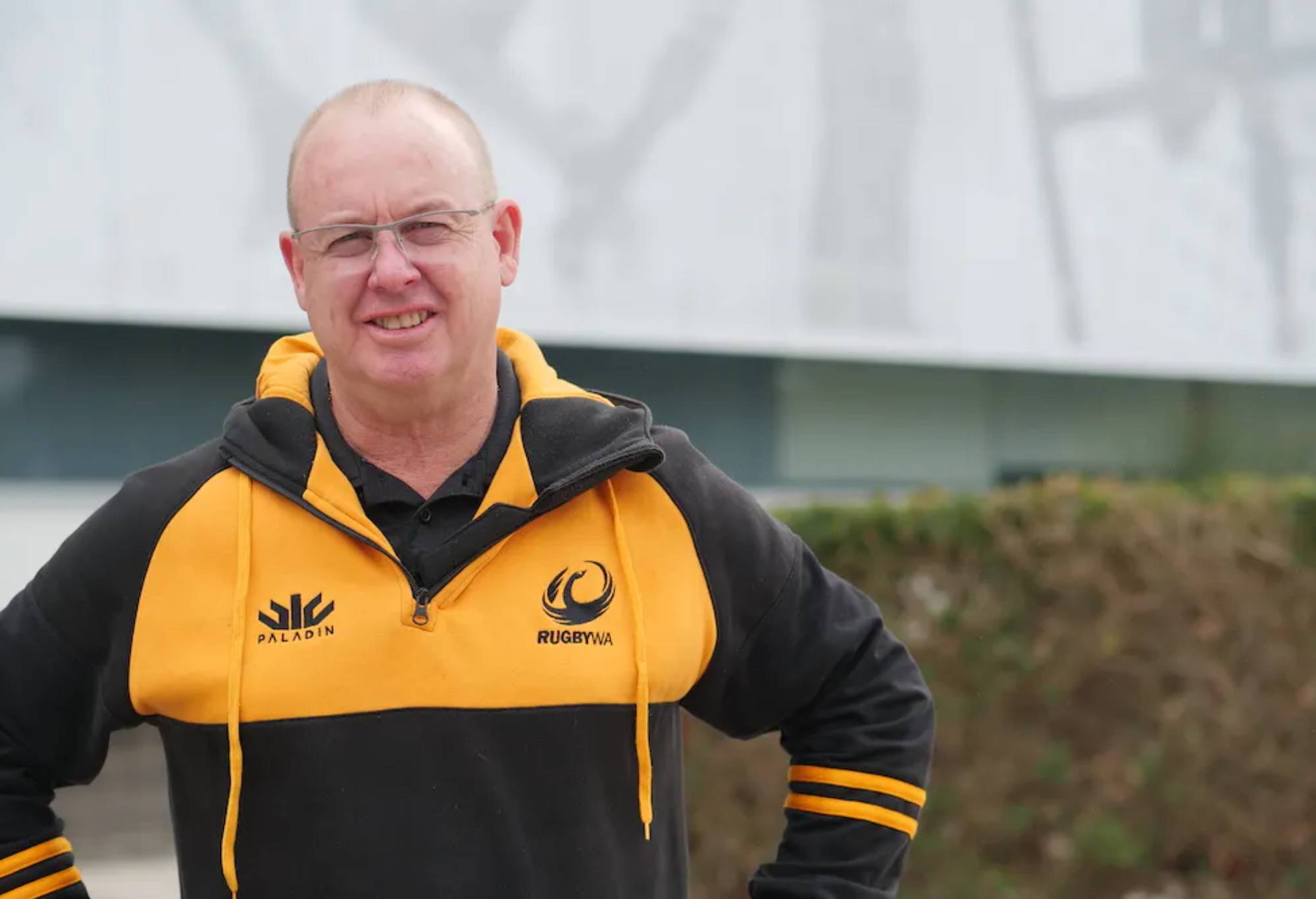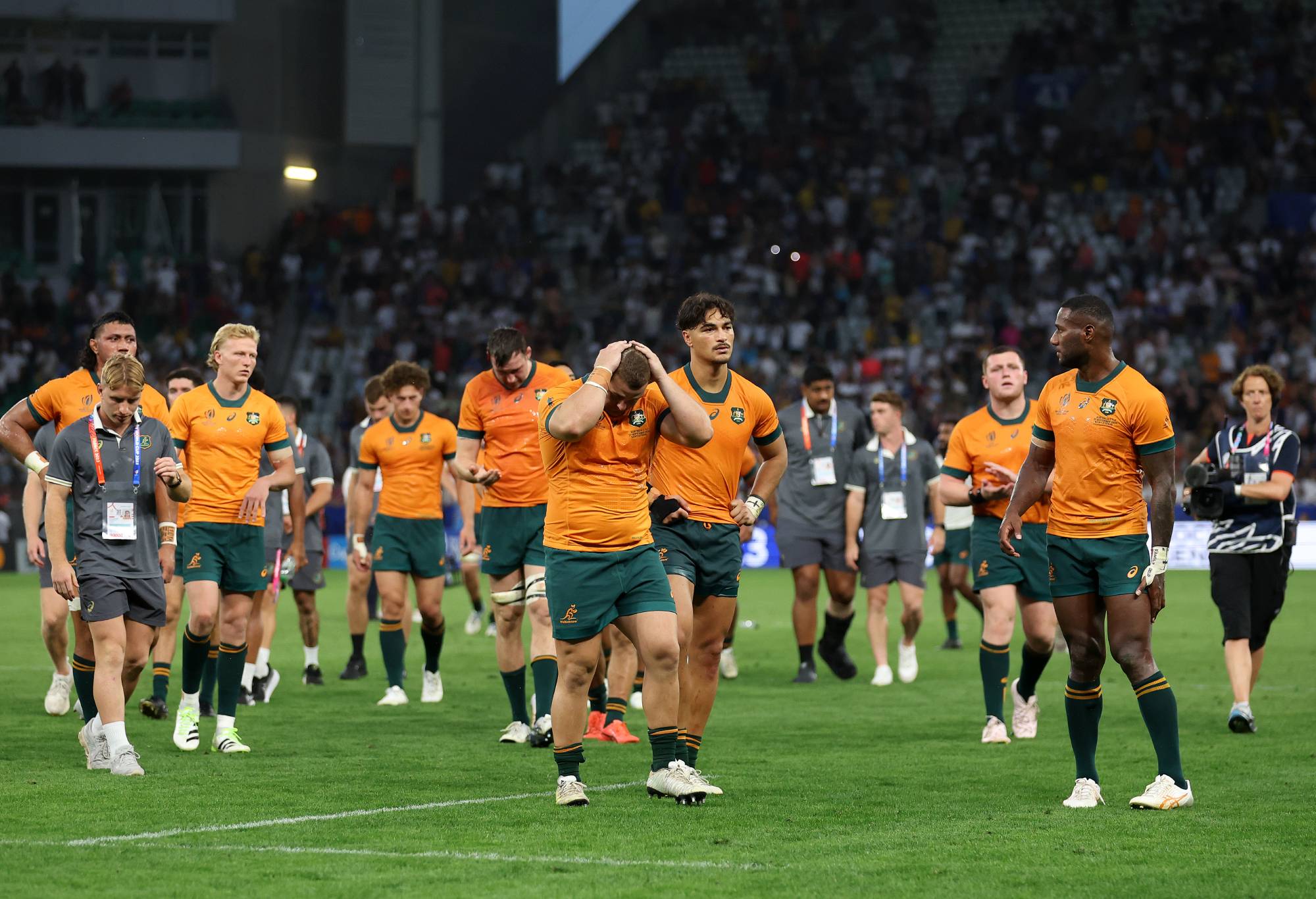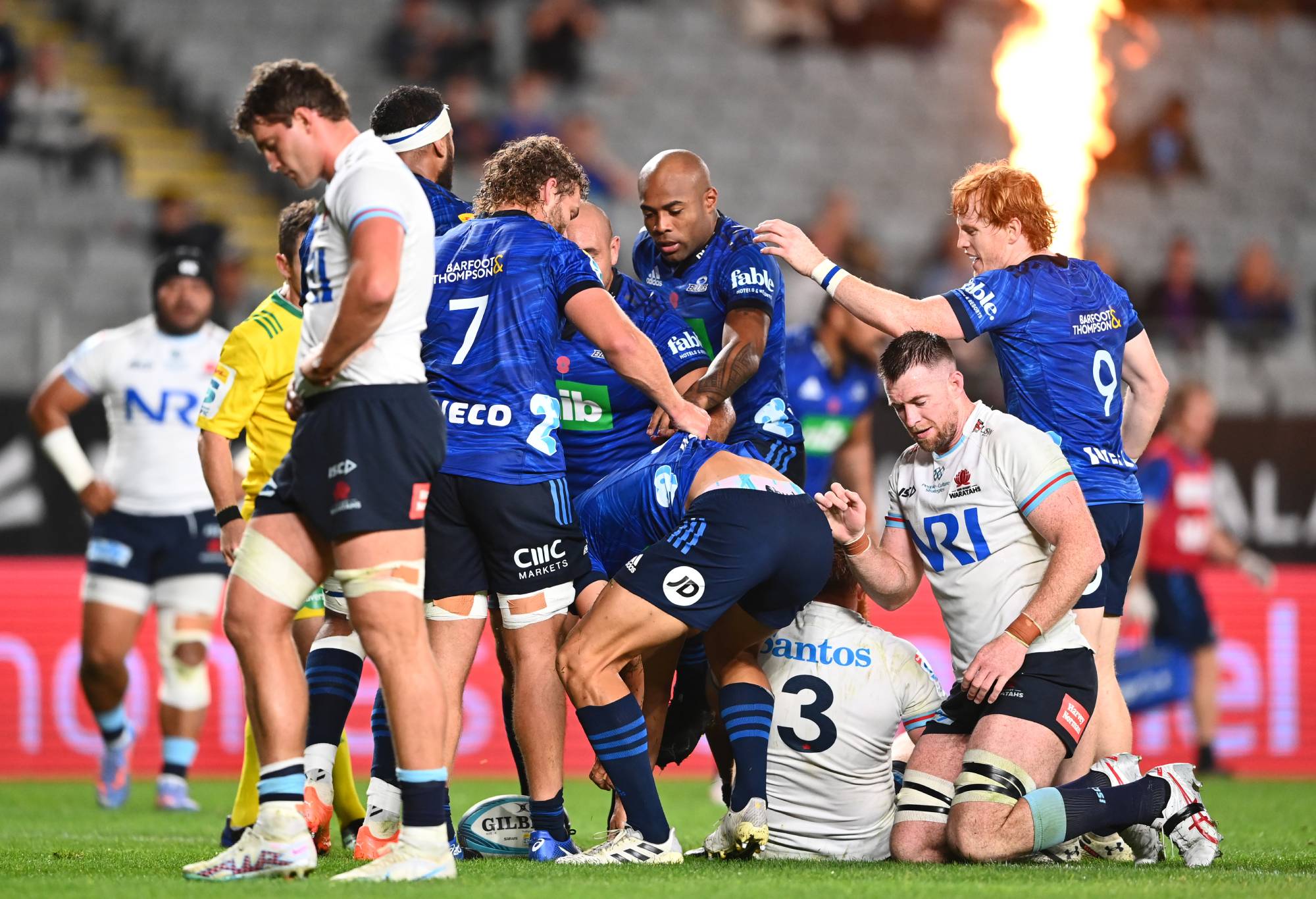The man who set up the high-performance systems in Scotland and Ireland has delivered a scathing critique of the apathy and factional landscape currently dogging Australian rugby, saying he warned executives that the Wallabies would drift into obscurity and drop to two-tier status unless action was taken to overhaul the system back in 2016.
“I made comments a fair while ago that we’d drop out of a tier one nation status,” Australian Steve Anderson told The Roar.
“If you don’t have a strong underbelly, you don’t build a critical mass of good quality coaching, even at participation level into pathway, you’re going to fail.
“If they keep band-aiding the issues, we’re just going to become a semi-professional sport at best.”

The Wallabies react following their loss to Wales in the World Cup at Parc Olympique on September 24, 2023 in Lyon. (Photo by Chris Hyde/Getty Images)
Tempers are high across the Australian rugby landscape after consecutive defeats in the World Cup left the Wallabies on the cusp of being eliminated in the pool stage of the tournament for the first time.
Only a capitulation from Fiji against Georgia and Portugal will give Eddie Jones’ side a hope of progressing to the quarter-finals.
Should the Wallabies miss the quarter-finals as expected, it will be yet another crushing blow for rugby in Australia.
The dire results, where Jones’ Wallabies have lost seven of eight Tests in 2023, have both the head coach and the Rugby Australia board that sensationally elected him to the role, including chairman Hamish McLennan, under serious pressure to keep their jobs. The results have seen the Wallabies win less than 40 per cent of Tests since 2016.
The political rumblings are a huge dent in RA’s desire to usher through crucial structural reform and move to a centralised system.
RA believes all efforts need to be made to come together, so the national team has the best chance of succeeding on the international stage.
That would see RA as the chief decision makers with regards to high performance and commercial.
However, the states, led by the Queensland Rugby Union, believe it’s a huge risk to allow the national body to have so much power.
They point to the failed World Cup campaign in France as one example why the governing body should not be the sole master and commander.
The anger currently permeating across the Australian rugby landscape has some member unions rallying others in a bid to overthrow the RA board.

Eddie Jones’ Wallabies are on the brink of their worst result at a Rugby World Cup. (Photo by Chris Hyde/Getty Images)
Yet, Anderson, who put the foundations in place for David Nucifora to build on with Ireland’s centralised model, has savaged the political factions within the game and says very few, including the states, are prepared to roll up their sleeves and make hard decisions for the betterment of the game.
“We’ve been three cars travelling down a three-lane highway side by side, where what we should be is three cars on top of one another,” said Anderson, who returned to work with the Western Force to set up their academy and briefly worked with RA.
“For some reason we just don’t get the connection between community, pathway and the performance ends of our game.
“These are the things that they need to be thrashed out and not be knee-jerk reactions either. There needs to be careful consideration to every aspect, financials through to performance through to the community game, what are the impacts there? There’s a whole host of areas that need to be considered.”
While some believe a move to a centralised system would mean RA would control tactics and styles, Anderson, who told The Roar ahead of the World Cup that the Wallabies had yet to hit rock bottom, says it couldn’t be further from the truth.
“Each environment has its own unique culture and its unique traditions, and they’ve got to be factored in,” he said.
“The stakeholder component is another area that we need to engage. So, what are their thoughts? What are their opinions? How does it work? What does it look like, what do we look like in 15 to 20 years time under a centralised model?”
Mick Byrne, who helped implement New Zealand Rugby’s centralised model following their continued failings at World Cups after 2007, agrees.
“A coach can come in with whatever tactic he wants, he can come in and say, ‘on counter-attack, if we don’t think we can get back to the 40, we’ll kick the ball.’ Well, that’s, that’s a strategy a head coach has,” Byrne told The Roar.
“Other head coaches go, ‘let’s play counter-attack for three rucks because we know we’re going in against unstructured defence and we’ll give ourselves three rucks to see if we can make a line break. And if we get a line break, then we’ll give another three rucks and see if we get another line break.’
“There’s a whole range of tactical strategies coaches can come up with.”

All Blacks great Dan Carter works with former New Zealand Rugby skills Coach Mick Byrne at Eden Park on June 7, 2013 in Auckland. (Photo by Phil Walter/Getty Images)
Byrne, who was tasked with upskilling teenagers across New Zealand, said that a centralised model would help elevate the skill sets of teenagers so that when they entered professional set-ups, coaches could implement whatever game plan they wanted because the technique of their players would stand up.
“At the end of the day, your players need to be able to run, catch, pass, pass over either foot maintaining pace, tackle left shoulder, tackle right shoulder with foot in close leg drive, get low body height, clean out the rucks with low body height,” Byrne said.
“Then the coach can say, ‘Well, I’ve got a player that can do all that at 18 or 19 years of age, I can now go and invent the greatest tactical game of all time because I’ve got a player who can do that because we’ve given them all those skill sets. That’s what needs to happen.”
Anderson added: “You’ve got to find commonality, you’ve got to find identity, and you’ve got to find purpose, and until we find that as a national entity, we’re going to struggle.”
Anderson believes there are no short-term fixes for Australian rugby, saying drastic change needs to occur to lift the game’s standing.
“We don’t have that hardened edge to our players,” he said.
“I look at the players on the field and think these guys that haven’t played enough footy. You only have to look at them.
“Players in Ireland are playing 26 to 30 games a year and they’re playing in different competitions, European Cup, the URC.
“There needs to be a major ‘think tank’, but they need to come out with solutions, or potential solutions.
“The time for talking and sidestepping and swerving without hitting the problems is over.
“There’s no immediate solution that’s going to give you immediate results. It’s a long-term view that needs major investment and a collective buy-in to get to an endpoint of revitalisation in the game.
“The quick fixes haven’t worked, particularly at the elite end of the game, which was always a problem for me. We are seeing the result of an unaligned program right now.”

Steve Anderson set up high performance programs in Ireland and Scotland, but was barely used in Australia. Photo: RugbyWA
Anderson believes very few people have been prepared to make the required hard decisions and embrace change over the past decade.
“Sometimes I used to get accused in these high-performance meetings when I was working in there of always bringing negativity to the table, but I was bringing reality, not negativity,” he said.
“You don’t say it unless it’s a problem.
“Now, if you think a problem is bringing negativity to the table, well, that’s just sidestepping the real issue. And that’s what’s been happening.
“I think, particularly the last six to eight years, people have looked at the massive issues and they’ve just turned away and gone ‘it’s too hard.’ And, as a result, we’re seeing the neglect that’s now coming out in the field.”
Indeed, it was in the 18 months leading up to the 2019 World Cup campaign in Japan where Anderson was asked to present at a national conference on the Gold Coast.
Yet, Anderson’s presentation was barely embraced.
“I’m still waiting for a reply on that,” he said.
“They’re all good people, but one bloke came back to me and said, ‘Ando, it’s a thesis.’
“I said, ‘Exactly. I’ve written it based on what we need to do.’”
At the same conference it was quickly established that no one had read the document, with others believing solutions would be made through winning the “hearts and minds” of Australians.
“It was asked, ‘Has anyone in this room read the document Steve sent out around academy and talent identification?’ Not one hand went up even though the document was sent out six weeks prior to a national conference,” Anderson said.
“This is the problem because it had a science edge to it, they didn’t want to know.”

The Wallabies react after losing to Fiji at the Rugby World Cup. (Photo by Catherine Ivill/Getty Images)
Rugby Australia general manager Adrian Thompson has since been moved on, with new RA chief executive Phil Waugh making the long-time official redundant in one of his first decisions in June.
Anderson, who was Chris Anderson’s assistant during the Melbourne Storm’s NRL win in 1999 and Kangaroos World Cup success in 2000 before switching to rugby union as a coach and then high-performance specialist, said he never felt respected in Australia.
“It showed me a contempt. I wasn’t a blow-in,” Anderson said. “This is the thing, and Mick [Byrne] was treated the same, we were treated as blow-ins and I never felt a part of it.
“Even though I had a job, I didn’t feel like my experience or opinions or views were valued. I’d just get crickets.”
Recently there has been a push to once again look at reducing the number of Australia’s five Super Rugby franchises.
Former All Blacks coach Steve Hansen is the latest to suggest RA should consider dropping a franchise to help its depth.
Anderson believes that is not necessary, saying the base needs to be expanded and the various strong grade competitions across the country backed further.
“I don’t see reducing the number of Super Rugby teams as the answer,” he said.
“Everyone’s pointing to when we were successful with three Super Rugby sides. But do you really need to go that far to try and give a sense of when we were successful, it’s not about when we were, it’s about addressing the needs of our environment right now and what is best to move forward in a productive manner.
“I still don’t understand how people in our game can’t get their heads around the fact that we’ve got a Super Rugby program that is not being supported by strong competitions.
“I still think the answer in that underbelly lies within our current club structures where they have all their traditions and cultures and all that sort of stuff in place.”
Byrne agrees.
“The easy answer is to say we need to reduce the number of Super Rugby teams, but that’s not the right answer,” he said.
“The right answer is to go and develop the talent that’s coming through schoolboy rugby and into 17s and 18-year-olds and develop them into Super Rugby players and get their skill-sets right.
“If we’ve got to fill up five Super Rugby teams, well, we have to go hard in our development of 16- and 17-year-olds. And you can. You can develop players, you can develop their skill sets, you can make people better.
“That’s what every other sport in the world does it. Every other sport in the world grabs a 17-year-old kid and turns him into a great player. Players aren’t really made in any code.”

Australia’s Super Rugby sides struggled on the whole again in 2023. (Photo by Hannah Peters/Getty Images)
Anderson said he left a program for Rugby WA to usher through, which would see a ‘Super Six’ grade competition played before the established 11-team premier competition got underway.
“Currently WA has 11 premier clubs but they’re not strong enough,” Anderson said.
“But we worked out we could get a really good comp if we had a Super Six, the top six sides, as distinct to 11, so they can service and be available to be able to move up and down.
“Once the Super season is over, they go back to their normal comp.
“My point is that that would support the Western Force and increase the underbelly underneath.
“That’s a strategy I left the Western Force and they’re still toying with it.”
Anderson recently applied for the vacant Rugby Australia head of high-performance. He was not given an interview.


































































































